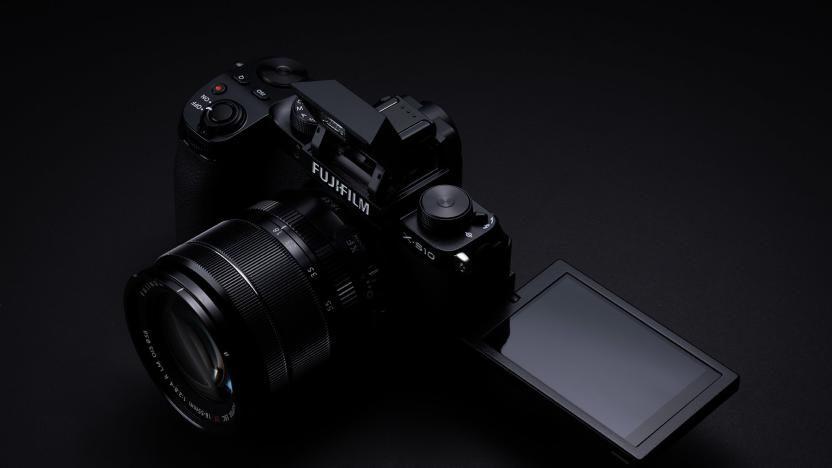IBIS
Latest

Fujifilm's X-S10 packs a lot of features into a $1,000 body
Fujifilm has unveiled the X-S10, a surprisingly powerful mid-range mirrorless camera. It has many of the features (and a similar price) to Fujifilm’s X-T30, including the 26.1-megapixel X-Trans sensor, 4K 30p video (10-bit external and 8-bit internal) and shooting speeds. However, it introduces a new body design and control layout, along with in-body stabilization, a flip-out display and more.

Smartwatches don't have to be ugly and this concept is proof
It's safe to say that in 2014, we're not short of smartwatches. But how many do you actually want to wear? That's a question that manufacturers are finally starting to ask themselves. It's also a question that Creoir -- who designs products for brands like Nokia and Jolla -- is trying to answer with its Ibis concept (shown above). Unlike most smartwatches, the Ibis was designed as a watch first. The elegant, metal design resembles a timepiece you would expect to see in a jewelry store. The "smart" part was conceived with the intention of supporting, not overwhelming the device's primary function. Essentially, the clock part is a regular watch face, while a small display sits beneath, ready to serve up notifications, calendar entries or let you answer and reject calls. While the hardware we saw was a prototype, we were also shown the user interface on a separate demonstration device. The UI has been skinned to complement the watch's design language, and runs on a pruned back version of Android. A working device would also include WiFi, Bluetooth 4.0, an accelerometer and USB connectivity. While the Ibis is very much a concept for now, Creoir has built products -- including smartwatches -- for a number of household names, including other watch-makers such as Suunto. So, while it might not be finding its way to your wrist any time soon, there's a very good chance a version, or "inspired-by" design will at some point.

Tokyo's IBIS robot promises cheaper surgery, throws shade at da Vinci (video)
"Anything you can do, I can do cheaper," says the Tokyo Institute of Technology while jabbing a rude elbow in the ribs of Intuitive Surgical. The Japanese institute is showing off IBIS, a surgical robot that is expected to cost between a third and a tenth of the $2 million it takes to buy one of Intuitive's da Vinci droids. Unlike its electrically powered American rival, IBIS is pneumatic, making it significantly cheaper and able to provide force feedback to surgeons when the arms touch something. The engineers behind the 'bot are hoping to produce a practical version within the next five years, and we're already thinking about inviting both machines along for a fight at Expand 2020. In the meantime, you can catch IBIS in action in the video after the break.

Ibis hotels to have robots paint art while they track your sleep: no, that's not creepy at all (video)
First they invaded our factories, and now it's our hotel rooms. Is nowhere safe from the robots? In truth, Ibis' upcoming Sleep Art project is very slick, even if it smacks of robot voyeurism. Ibis hotels in Berlin, London and Paris will let 40 successful applicants sleep on beds that each have 80 sensors translating movements, sound and temperature into truly unique acrylic paintings by robotic arms connected through WiFi. You don't have to worry that the machines are literally watching you sleep -- there's no cameras or other visual records of the night's tossing and turning, apart from the abstract lines on the canvas. All the same, if you succeed in landing a stay in one of the Sleep Art hotel rooms between October 13th and November 23rd, you're a brave person. We all know how this ends.

OCZ Ibis touts 2GBps High Speed Data Link, vanquishes SSD competition
What's after ludicrous speed? If you ask OCZ, the answer is HSDL speed, which is the company's new interface idea for bypassing the bandwidth limitations of standard SATA/SAS interconnects. Using a high-quality SAS cable to hook up its new Ibis drive to a PCI Express host card, OCZ has managed to deliver a cool 2GBps of total bandwidth -- that's one gigabyte up and one gigabyte down... every second. In order to feed this massive data pipe, the company's gone and stacked four SandForce SF-1200 controllers inside the Ibis and RAIDed them together for good measure too. The upshot isn't too dramatic for desktop applications, where'll you'll see performance that's merely world-beating -- reading at 373MBps and writing at 323MBps -- but if you throw in some deeper queues and enterprise-level workloads you'll be able to squeeze out 804MBps reads and 675MBps writes. Needless to say, the Ibis scooped up many a plaudit in early reviews, and though it may be expensive at $529 for 100GB, it still seems to represent good value for those who have the workloads to saturate its High Speed Data Link.



